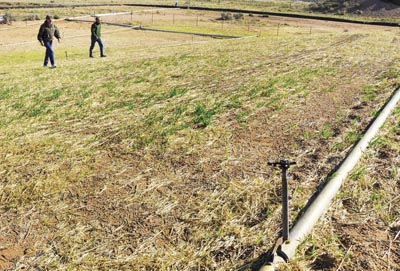Report: Sandia Mixed Waste Landfill not source of trace solvent detected in groundwater

An investigation by DOE and Sandia has concluded the Mixed Waste Landfill is not the source of very low concentrations of toluene detected in groundwater samples collected from monitoring wells at the site. Toluene is a common solvent found in paint thinners, gasoline, and other consumer products.
Don Schofield (4133, left) and Mike Mitchell (6765) check on the establishment of the new vegetation on the Mixed Waste Landfill cover in this photo from late 2009. Construction on the cover was completed a year ago. A recent investigation has found the landfill is not the source of trace amounts of toluene detected in nearby groundwater samples. (Photo by Randy Montoya)
The results of the investigation were published in the Mixed Waste Landfill Toluene Investigation Report and submitted in August to the New Mexico Environment Department (NMED), which requested the investigation in April.
The Mixed Waste Landfill was established in 1959 as a disposal area for low-level radioactive waste generated by Sandia’s research facilities.
The toluene concentrations detected in groundwater samples near the 2.6-acre site are significantly lower than the federal drinking water standard for toluene of 1,000 parts per billion. And, the concentrations are very close to the detection limit of 0.25 parts per billion set by the independent analytical laboratory subcontracted by Sandia.
This investigation also indicates that the analytical laboratory that tested the groundwater samples is the source of toluene reported in some samples.
“The toluene groundwater results reflect the ubiquitous nature of toluene and the very low analytical detection limit (of 0.25 parts per billion),” the report’s executive summary states. “The detections do not represent a release to the environment or widespread low-concentration toluene contamination in the regional aquifer.”
Toluene is a common volatile organic liquid, which means it easily turns to vapor at ambient temperatures. It is present in many workplaces and consumer products and has been identified by the US Environmental Protection Agency as a common laboratory contaminant. It is also released into the atmosphere by manufacturing plants and automobile emissions.
Toluene is present in urban air at very low concentrations of 0.01 to 0.05 parts per million — in other words, at concentrations higher than was detected in the groundwater samples collected near the Mixed Waste Landfill.
The extensive investigation on the source of the toluene included a review of the results from all previous Mixed Waste Landfill field investigations; a review of soil-vapor surveys conducted in 1994 and 2008; a review and analysis of all Sandia groundwater monitoring results from 2001 through April 2010; and evaluation of the possible introduction of toluene from the sampling equipment and process, the drilling and well construction materials and processes, and during testing at the analytical laboratory. DOE and Sandia also completed additional groundwater studies as requested by NMED.
Results of the current and previous investigations show that toluene has never been found in concentrations that would affect regional groundwater, which occurs at a depth of 500 feet, so the chemical is not considered a significant contaminant at the site.
Toluene has been sporadically detected in groundwater samples collected prior to 2008 and continues to be detected in groundwater samples from all four groundwater monitoring wells installed in 2008, including the background well, at very low concentrations, typically less than one part per billion.
The Mixed Waste Landfill is located in Technical Area 3 in the west-central part of Kirtland Air Force Base about five miles southeast of the Albuquerque airport. For the past 20 years, groundwater monitoring beneath the site has demonstrated that the materials disposed in the landfill have not contaminated the groundwater. The landfill stopped accepting waste in 1988.
DOE and Sandia, in coordination with the NMED, will continue to closely monitor the groundwater beneath the landfill and will continue testing for toluene. — Heather Clark